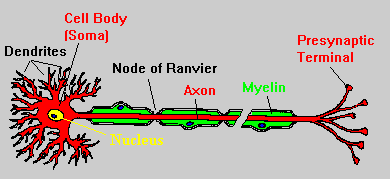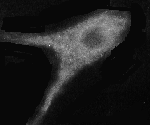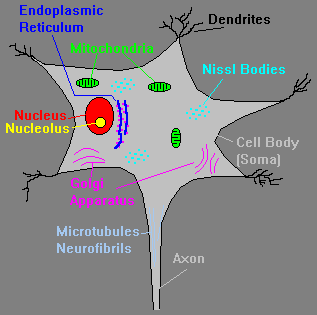Neuroscience For Kids
Types of Neurons (Nerve Cells)
 The human body is made up of trillions of cells. Cells of the nervous
system, called nerve cells or neurons, are specialized to
carry "messages" through an electrochemical process. The human brain has
approximately 86 billion neurons. To learn how neurons carry messages,
read about the action potential.
The human body is made up of trillions of cells. Cells of the nervous
system, called nerve cells or neurons, are specialized to
carry "messages" through an electrochemical process. The human brain has
approximately 86 billion neurons. To learn how neurons carry messages,
read about the action potential.
Neurons come in many different shapes and sizes. Some of the smallest neurons have cell bodies that are only 4 microns wide. Some of the biggest neurons have cell bodies that are 100 microns wide. (Remember that 1 micron is equal to one thousandth of a millimeter!).
Neurons are similar to other cells in the body because:
- Neurons are surrounded by a cell membrane.
- Neurons have a nucleus that contains genes.
- Neurons contain cytoplasm, mitochondria and other organelles.
- Neurons carry out basic cellular processes such as protein synthesis and energy production.
However, neurons differ from other cells in the body because:
- Neurons have specialize cell parts called dendrites and axons. Dendrites bring electrical signals to the cell body and axons take information away from the cell body.
- Neurons communicate with each other through an electrochemical process.
- Neurons contain some specialized structures (for example, synapses) and chemicals (for example, neurotransmitters).
The Neuron

One way to classify neurons is by the number of extensions that extend from the neuron's cell body (soma).

Bipolar neurons have two processes
extending from the cell body (examples: retinal cells,
olfactory epithelium cells).

Pseudounipolar cells (example: dorsal
root ganglion cells). Actually, these cells have 2 axons rather than an
axon and dendrite. One axon extends centrally toward the spinal cord, the
other axon extends toward the skin or muscle.

Multipolar neurons have many processes that extend from
the cell body. However, each neuron has only one axon (examples: spinal
motor neurons, pyramidal neurons, Purkinje cells).
Neurons can also be classified by the direction that they send information.
- Sensory (or afferent) neurons: send information from sensory receptors (e.g., in skin, eyes, nose, tongue, ears) TOWARD the central nervous system.
- Motor (or efferent) neurons: send information AWAY from the central nervous system to muscles or glands.
- Interneurons: send information between sensory neurons and motor neurons. Most interneurons are located in the central nervous system.

Check out the Gallery of Neurons to see some pictures of real neurons or "Sidewalk Cells" to see photographs of neurons on the street.
 Hear It Hear It |
| "Neuron" | "Axon" | "Dendrite" | |
| "Nissl" | "Mitochondria" | "Endoplasmic reticulum" |
There are several differences between axons and dendrites:
| Axons | Dendrites |
|
|

What is inside of a neuron? A neuron has many of the same organelles such as mitochondria, cytoplasm and a nucleus, as other cells in the body.
- Nucleus - contains genetic material (chromosomes) including information for cell development and synthesis of proteins necessary for cell maintenance and survival. Covered by a membrane.
- Nucleolus - produces ribosomes necessary for translation of genetic information into proteins
- Nissl Bodies - groups of ribosomes used for protein synthesis.
- Endoplasmic reticulum (ER) - system of tubes for transport of materials within cytoplasm. Can have ribosomes (rough ER) or no ribosomes (smooth ER). With ribosomes, the ER is important for protein synthesis.
- Golgi Apparatus - membrane-bound structure important in packaging peptides and proteins (including neurotransmitters) into vesicles.
- Microfilaments/Neurotubules - system of transport for materials within a neuron and may be used for structural support.
- Mitochondria - produce energy to fuel cellular activities.
Did you know? |
Neurons are the oldest and longest cells in the body! You have many of the same neurons for your whole life. Although other cells die and are replaced, many neurons are never replaced when they die. In fact, you have fewer neurons when you are old compared to when you are young. On the other hand, data published in November 1998 show that in one area of the brain (the hippocampus), new neurons CAN grow in adult humans. Neurons can be quite large - in some neurons, such as corticospinal neurons (from motor cortex to spinal cord) or primary afferent neurons (neurons that extend from the skin into the spinal cord and up to the brain stem), can be several feet long! Happy 126th Birthday to the Golgi apparatus! In 1898, the famous neuroanatomist Camillo Golgi reported his discovery of a ribbon-like apparatus inside neurons of the cerebellum. This structure now bears his name as the "Golgi apparatus." |

- Take a short review quiz about the parts of a neuron..
- Color a neuron or several neurons online!
- Try the Neuron Review Test. (Requires the Adobe Acrobat Reader. Answers to the Neuron Review Test.
Copyright © 1996-2024, Eric H. Chudler All Rights Reserved.

